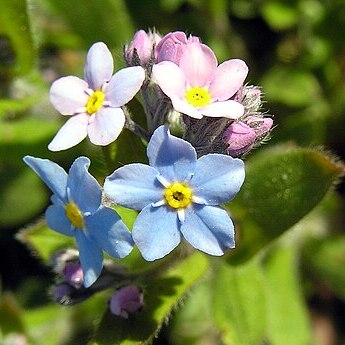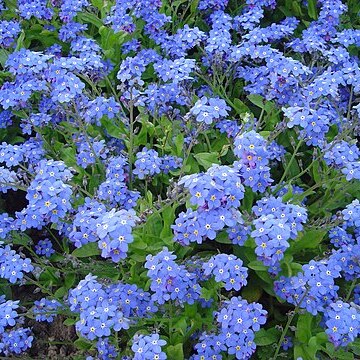Annual or perennial erect usually hairy herbs. Leaves alternate, mostly oblong or lanceolate, entire, the basal ones shortly petiolate, the cauline ones sessile. Flowers small in scorpioid cymes. Calyx campanulate, 5-toothed or divided to just below the middle into 5 mostly narrow lobes, persistent, not or slightly accrescent in fruit. Corolla blue, white or yellow; tube cylindric or funnel-shaped, the throat usually with scales, papillae or swellings; lobes 5, spreading, contorted in bud. Stamens 5, included or exserted; filaments filiform; anthers linear, with the connective prolonged into a small trulliform appendage. Disc absent. Ovary deeply 4-lobed; style gynobasic, filiform; stigma obtuse. Fruit composed of 4 erect, oblong-ovoid glabrous shining nutlets fixed by a small basal areole to the flat or convex receptacle.
Herbs annual or perennial, short pubescent or glabrescent. Leaves alternate. Cymes becoming racemelike after anthesis, ebracteate or rarely with few bracts. Calyx 5-lobed or parted, slightly enlarged or not in fruit. Corolla blue or white, rarely light purple, usually salverform, rarely campanulate or funnelform; throat appendages 5, scalelike; lobes 5, spreading, rotund, margin convolute. Stamens included; anthers ovate to elliptic, apex obtuse. Ovary 4-parted. Style linear; stigma discoid, mucronate. Gynobase flat or slightly convex. Nutlets 4, usually ovate, appressed, lenticular, vertical, smooth, shiny; attachment scar basal.
Fls us. in cymes, ebracteate, bracteate only at base, or with lflike bract associated with each fl., occ. solitary and terminal; calyx persistent; corolla-tube infolded to form "scales" or "glands" at throat, lobes contorted in bud; stamens with anthers either at least partly below scales, or wholly above scales; ovary 4-celled, style slender; nutlets 4, smooth and shining, mostly dark brown or black when mature. Annual or perennial hairy herbs. More than 50 spp. mostly of temperate lands. Of 34 spp. in N.Z. all are endemic except possibly some forms here included under the Australian M. australis, and perhaps M. antarctica.
Annual, biennial or perennial, ± hairy herbs. Habit from cushion form to erect or sprawling. Infl. usually cymose, ebracteate or bracteate, often enlarged at fruiting. Calyx 5-toothed, often accrescent. Corolla ± rotate; tube short, infolded to form 5 scales at throat; limb of 5 equal lobes, patent or concave, contorted in bud, blue, purple, white, yellow, brown or orange. Stamens with anthers either partly below scales (sect. Myosotis) or wholly above them (sect. Exarrhena). Ovary 4-celled; style slender. Nutlets 4, ovoid, brown or black, smooth and glossy, often with a distinct rim.
Cor salverform to broadly funnelform, equaling to much exceeding the cal, the throat obstructed by the fornices; stamens included; nutlets smooth and shining, with an evident raised margin all the way around, and with a small, basilateral scar, the gynobase low and broad; glabrous or strigose (but not hispid or setose) herbs with blue or less often white (rarely yellow) fls in terminal, naked, helicoid cymes (“racemes”), or the lower fls scattered among the lvs; fruiting pedicels erect or spreading. 50, temp. and boreal.


